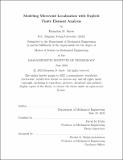| dc.contributor.advisor | Parks, David M. | |
| dc.contributor.author | Snow, Brandon D. | |
| dc.date.accessioned | 2023-08-23T16:13:04Z | |
| dc.date.available | 2023-08-23T16:13:04Z | |
| dc.date.issued | 2023-06 | |
| dc.date.submitted | 2023-07-19T18:45:42.492Z | |
| dc.identifier.uri | https://hdl.handle.net/1721.1/151845 | |
| dc.description.abstract | Ductile fracture is characterized by the micromechanisms of void nucleation, growth, and coalescence. Numerical modeling of these micromechanical phenomena has typically been performed with an implicit finite element analysis (FEA) solver, which accurately produces quasi-static results, but introduces limitations in terms of computational expense and the ability to model highly non-linear processes. This has resulted in the majority of studies being restricted to single void representative volume elements (RVEs) under applied stress-states with moderate to large triaxialities. In this thesis, those limitations are largely overcome by solving microvoid localization problems with the explicit FEA method. A general framework for applying periodic boundary conditions and controlling the RVE-average stress-state is introduced and applied to both implicit and explicit FEA. Then, using the framework, a comparison of implicit and explicit FEA simulations of microvoid localization demonstrates that quasi-static results can be produced using the explicit FEA method with a significant reduction in computational cost. General guidelines for performing quasi-static explicit FEA simulations of RVE behavior are established that should be generally applicable to a wide range of micromechanics problems. Lastly, the explicit FEA method is applied to more complex RVEs which contain internal elastic particles. The simulations demonstrate that the presence of internal particles can accelerate microvoid localization under low triaxiality deformation, especially for low strain hardening materials. The results of the particle-containing RVE simulations have implications for precipitation strengthened alloys as well as metal matrix composites that utilize hard particles/phases to increase strength. The simulation capabilities introduced in this work highlight new opportunities to improve our collective understanding of ductile failure which will hopefully lead to better predictive capabilities and new materials designed to resist fracture. | |
| dc.publisher | Massachusetts Institute of Technology | |
| dc.rights | In Copyright - Educational Use Permitted | |
| dc.rights | Copyright retained by author(s) | |
| dc.rights.uri | https://rightsstatements.org/page/InC-EDU/1.0/ | |
| dc.title | Modeling Microvoid Localization with Explicit
Finite Element Analysis | |
| dc.type | Thesis | |
| dc.description.degree | S.M. | |
| dc.contributor.department | Massachusetts Institute of Technology. Department of Mechanical Engineering | |
| dc.identifier.orcid | 0000-0001-5743-6700 | |
| mit.thesis.degree | Master | |
| thesis.degree.name | Master of Science in Mechanical Engineering | |
